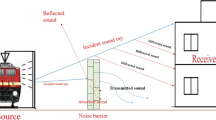Abstract
Due to their disproportionate geometries and uneven distribution of sound, the interior sound field analysis of subway stations has always been challenging. The field necessitates reliable tools for real-case design applications, while the research and discussions on the topic are still ongoing. This study compares two major room acoustics simulation approaches, namely ray tracing and diffusion equation modeling (DEM) in order to assist future acoustical designs of subway stations. Two cases of Istanbul Metropolitan metro lines are selected, namely station BAG with a circular cross section and station USK with rectangular cross section. The reverberation time and relative sound pressure level results from field tests are compared with those obtained by the ray tracing and DEM. The results emphasized the validity as well as limitations of each method over discussed metrics with given geometric layouts and material characteristics of the subway stations.










Similar content being viewed by others
References
Turkish Environmental Noise Act of 2010, Article 12, Passage 3, Table 5
Sü, Z., Çalıskan, M.: Acoustical design and noise control in metro stations: case studies of the Ankara metro system. Build. Acoust. 14(3), 231–249 (2007)
Kootwijk, P.A.A.: The speech intelligibility of the public address systems at 14 Dutch railway stations. J. Sound Vib. 193(1), 433–434 (1996)
Nowicka, E.: Assessing the acoustical climate of underground stations. Int. J. Occup. Saf. Ergon. (JOSE) 13(4), 427–431 (2007)
Kim, Y.H., Soeta, Y.: Architectural treatments for improving sound fields for public address announcements in underground station platforms. Appl. Acoust. 74, 1205–1220 (2013)
Shimokura, R., Soeta, Y.: Sound field characteristics of underground railway stations—effect of interior materials and noise source positions. Appl. Acoust. 73, 1150–1158 (2012)
Kang, J.: Acoustics of long underground spaces. Tunn. Undergr. Space Technol. 12(1), 15–21 (1997)
Kang, J.: Scale modelling for improving the speech intelligibility from multiple loudspeakers in long enclosures by architectural acoustic treatments. Acta Acust. 84, 689–700 (1998)
Beranek, L.L.: Acoustics. McGraw-Hill, New York (1954)
Davies, H.G.: Noise propagation in corridors. J. Acoust. Soc. Am. 53(1973), 1253–1262 (1973)
Doak, P.E.: Fundamentals of aerodynamic sound theory and flow duct acoustics. J. Sound Vib. 28, 527–561 (1973)
Li, K.M., Lu, K.K.: Propagation of sound in long enclosures. J. Acoust. Soc. Am. 116(5), 2759–2770 (2004). https://doi.org/10.1121/1.1798351
Kang, J.: A method for predicting acoustic indices in long enclosures. Appl. Acoust. 51(2), 169–180 (1997)
Yang, L.N., Shield, B.M.: Development of a ray-tracing computer model for the prediction of the sound field in long enclosures. J. Sound Vib. 229(1), 133–146 (2000)
Picaut, J., Simon, L., Polack, J.D.: Sound field in long rooms with diffusely reflecting boundaries. Appl. Acoust. 56, 217–240 (1999)
Valeau, V., Picaut, J., Hodgson, M.: On the use of a diffusion equation for room acoustic prediction. J. Acoust. Soc. Am. 119(3), 1504–1513 (2006)
Pollès, T.L., Picaut, J., Bérengier, M.: Sound field modeling in a street canyon with partially diffusely reflecting boundaries by the transport theory. J. Acoust. Soc. Am. 116(5), 2969–2983 (2004)
Jing, Y., Larsen, E.W., Xiang, N.: One-dimensional transport equation models for sound energy propagation in long spaces: theory. J. Acoust. Soc. Am. 127(4), 2312–2322 (2010). https://doi.org/10.1121/1.3298936
Jing, Y., Xiang, N.: One-dimensional transport equation models for sound energy propagation in long spaces: simulations and experiments. J. Acoust. Soc. Am. 127(4), 2323–2331 (2010). https://doi.org/10.1121/1.3303981
Redmore, T.L.: A theoretical analysis and experimental study of the behavior of sound in corridors. Appl. Acoust. 15, 161–170 (1982)
Sü Gül, Z., Xiang, N., Çalışkan, M.: Investigations on sound energy decays and flows in a monumental mosque. J. Acoust. Soc. Am. 140(1), 344–355 (2016)
Sü Gül, Z., Xiang, N., Çalışkan, M.: Diffusion equation based finite element modeling of a monumental worship space. J. Comput. Acoust. 25(4), 1–16 (2017)
Sü Gül, Z., Odabaş, E., Xiang, N., Çalışkan, M.: Diffusion equation modeling for sound energy flow analysis in multi domain structures. J. Acoust. Soc. Am. 145(4), 2703–2717 (2019). https://doi.org/10.1121/1.5095877
Ollendorff, F.: Statistical room-acoustics as a problem of diffusion. Acustica 21, 236–245 (1969)
Kuttruff, H.: Room Acoustics, 4th edn. Spon Press, London (2000)
Billon, A., Picaut, J., Sakout, A.: Prediction of the reverberation time in high absorbent room using a modified-diffusion model. Appl. Acoust. 69, 68–74 (2008)
Jing, Y., Xiang, N.: On boundary conditions for the diffusion equation in room acoustic prediction: theory, simulations, and experiments. J. Acoust. Soc. Am. 123(1), 145–153 (2008)
Visentin, C., Prodi, N., Valeau, V., Picaut, J.: A numerical investigation of the Fick’s law of diffusion in room acoustics. J. Acoust. Soc. Am. 132(5), 3180–3189 (2013). https://doi.org/10.1121/1.4756924
Navarro, J.M., Jacobsen, F., Escolano, J., López, J.J.: A theoretical approach to room acoustic simulations based on a radiative transfer model. Acta Acust. United Acust. 96, 1078–1089 (2010). https://doi.org/10.3813/AAA.918369
Navarro, J.M., Escolano, J.: Simulation of building indoor acoustics using an acoustic diffusion equation model. J. Build. Perform. Simul. 8(1), 3–14 (2013). https://doi.org/10.1080/19401493.2013.850534
Brinkmann, F., Aspöck, L., Ackermann, D., Lepa, S., Vorländer, M., Weinzierl, S.: A round robin on room acoustical simulation and auralization. J. Acoust. Soc. Am. 145(4), 2746–2760 (2019)
Morse, P., Feshbach, H.: Methods of Theoretical Physics. McGraw-Hill, New York (1955)
Xiang, N., Escolano, J., Navarro, J.M., Jing, Y.: Investigation on the effect of aperture sizes and receiver positions in coupled rooms. J. Acoust. Soc. Am. 133(6), 3975–3985 (2013)
Sü Gül, Z., Çalışkan, M., Tavukcuoglu, A., Xiang, N.: Assessment of acoustical indicators in multi-domed historic structures by non-exponential energy decay analysis. Acoust. Aust. 46, 181–192 (2018)
Acknowledgements
The authors gratefully acknowledge the subcontractor for engineering services, Prota Engineering Inc., contractor, Doğuş Construction Inc. of Istanbul, and operator, Metro Istanbul, for their collaboration in design process and support in providing permissions for the field measurements.
Author information
Authors and Affiliations
Corresponding author
Additional information
Publisher's Note
Springer Nature remains neutral with regard to jurisdictional claims in published maps and institutional affiliations.
Rights and permissions
About this article
Cite this article
Sü Gül, Z., Odabaş, E. & Çalışkan, M. Comparative Evaluation of Ray Tracing and Diffusion Equation Modeling in Room Acoustics Design of Subway Stations. Acoust Aust 48, 93–105 (2020). https://doi.org/10.1007/s40857-020-00179-1
Received:
Accepted:
Published:
Issue Date:
DOI: https://doi.org/10.1007/s40857-020-00179-1




